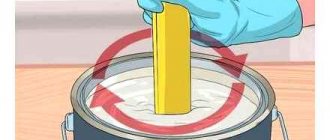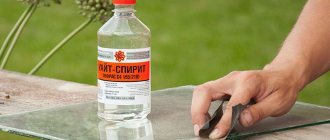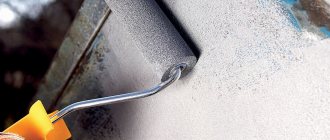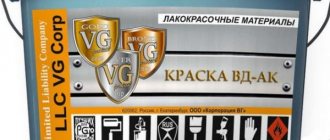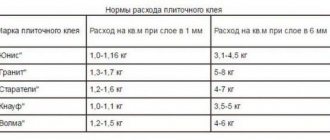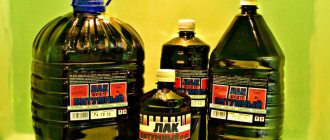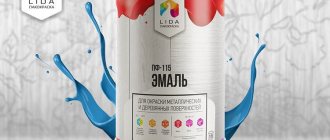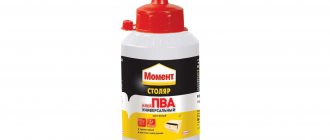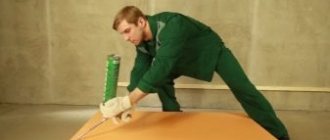These paint and varnish consumption rates are averaged and are intended for planning the production needs for paints and varnishes and auxiliary materials for the manufacture of steel building structures of buildings and structures.
The average structure area is 24 m2/t.
The consumption rate of paints and varnishes is set for one layer of coating. The GF-021 primer has a specified consumption rate for a layer thickness of 20 microns (temporary protection for the period of transportation, storage and installation of metal structures).
The most common (frequently encountered) system of anti-corrosion protection of steel structures: GF-021 primer in two layers + PF-115 enamel in two layers.
As interest arises or requests for others arise, the article will be supplemented.
Anti-corrosion protection of structures
| Brand | Color | Coating thickness, microns | Consumption rate, kg/t |
| Glypthal primers | |||
| GF-017 | Dark brown | 17 | 2,73 |
| GF-021 | Red-brown | 17 | 2,43 |
| 20 | 2,84 | ||
| Pentaphthalic enamels | |||
| PF-115 | Brown | 21 | 2,31 |
| Grey | 21 | 2,15 | |
| Dark grey | 21 | 2,25 | |
| Perchlorovinyl enamels | |||
| XB-16 | Dark grey | 17 | 5,17 |
| XB-110 | Grey | 17 | 3,04 |
| XB-113 | Grey | 17 | 3,17 |
| ХВ-518 | Grey | 17 | 4,60 |
| XB-785 | Grey | 17 | 4,10 |
| Red-brown | 17 | 4,27 | |
Anti-corrosion protection of tanks
Solvent consumption rates
| Paint material | Solvent | Consumption rate, kg/t | |
| Name | GOST, TU | ||
| GF-017 | Solvent xylene or mixture with white spirit 1:1 | GOST 10214-78, 1928-79 | 0,41 |
| GF-021 | GOST 9949-76 | 0,37 | |
| GOST 9410-78 | 0,43 | ||
| PF-115 | Solvent, white spirit, turpentine | 0,35 | |
| PF-133 | Solvent, xylene | GOST 1928-79, GOST 9410-78 | 0,36 |
| PF-1189 | Solvent or a mixture of xylene and white spirit 1:1 | GOST 10214-78, GOST 1928-79 | 0,90 |
| XB-16 | R-5 | GOST 7827-74 | 1,03 |
| XB-110 | R-24 | GOST 7827-74 | 1,22 |
| XB-113 | R-24 | GOST 7827-74 | 1,3 |
| ХВ-518 | R-4 | GOST 7827-74 | 0,92 |
| XB-785 | R-4 | GOST 7827-74 | 1,71 |
| BT-577 | White spirit, solvent, turpentine | 0,32 | |
Consumption standards for paints and varnishes depending on the coating application method
| Brand | Color | Consumption standard, g/m2*µm | ||
| pneumatic spray | airless spray | jet dousing | ||
| BT-577 | Black | 4,27 | 4,05 | 4,05 |
| GF-017 | Dark brown | 5,1 | 4,85 | 4,85 |
| GF-021 | Dark brown | 4,57 | 4,34 | 4,34 |
| PF-115 | Grey | 3,25 | 3,10 | 3,10 |
| Dark grey | 3,41 | 3,24 | 3,24 | |
| Brown | 3,49 | 3,32 | 3,32 | |
| PF-1189 | Grey | 4,04 | 3,84 | — |
| XB-16 | Dark grey | 9,32 | 8,85 | — |
| HF-110 | Grey | 5,47 | 5,20 | |
Coefficients of complexity groups of painted structures
Coefficients of use of paints and varnishes
More details about the consumption of paints and varnishes and auxiliary materials can be found in VSN 426-86.
Removal of corrosion products and degreasing
To remove corrosion products (rust) from the surface of metals, mechanical and chemical methods are used. In the first case, they use various mechanized tools or clean the metal manually with steel brushes, scrapers, sandpaper or other abrasive material. This treatment must be done very carefully, since corroded metal is fragile and easily damaged. Mechanical cleaning usually begins with removing rust from easily accessible places. Hard-to-reach areas, gaps, cracks, places where parts are joined by welding and bolts are cleaned of rust with scrapers and steel needles.
Removing rust mechanically is a difficult and time-consuming process. To make it easier, car enthusiasts come up with various tools. For example, a simple method has been proposed for manufacturing a device for cleaning rust from hard-to-reach areas of the body. For this purpose, a piece of steel cable with a diameter of 10 and a length of 500 mm is cut off. The cable is inserted into a pipe with a diameter of 14 and a length of 500 mm so that 25 mm of cable protrudes from both sides of the pipe, after which the ends of the pipe are clamped in a vice (Fig. 2). Naturally, the dimensions of the cable and pipe in the manufacture of devices of the described type can be very different.
Light rust is removed manually using coarse (coarse-grained) sandpaper. To facilitate work and reduce dust formation, “wet” cleaning can be performed. In this case, the surface of the metal to be cleaned must be moistened with white spirit or kerosene, and then polished as usual. A freshly cleaned metal surface easily rusts, so it is not recommended to leave cleaned surfaces for a long time without a protective coating.
The process of removing oxides and hydrates of metal oxides from the surface of a metal by chemical methods is called etching. It is usually carried out by treating products with solutions of acids or acid salts.
Using chemical rust removers makes the job much easier. However, it must be remembered that if, after treatment with preparations containing acid, their residues are not thoroughly removed, then in the future they themselves can contribute to the development of corrosion.
Before etching, the surface must be degreased, because residual grease and fat impair its wettability and etching proceeds unevenly. The etching process consists of the following operations: degreasing, treatment with an acid-containing composition, rinsing with water, rinsing with a neutralizing composition, rinsing with water, drying.
Stores sell ready-to-use compositions for removing rust from metal surfaces. The most common is “Omega-1 Auto Rust Cleaner”. It is a mixture of orthophosphoric acid, carboxymethyl cellulose, aerosil and a corrosion inhibitor. Before use, the cleaner must be mixed well, and then applied with a spatula or brush in a layer of 1-3 mm to the rusty surface and left on it for 5-30 minutes (depending on the thickness of the rust layer). After this, remove the cleaner with a dry cloth or brush and wipe the surface dry. Cleaner consumption is 0.8-1.2 kg per 1m2. Walrus paste has similar properties.
Rice. 1. Device for cleaning metal from rust
The composition is applied to the car body with a brush, kept for 3-5 minutes at a temperature of 20-25 ° C, after which it is washed off with warm water. Residues of acid are removed with neutralizing composition No. 107, consisting of 47.5% ethyl alcohol, 2.5% ammonia and 50% water.
Etching pastes based on hydrochloric acid have become widespread.
To obtain pastes, you must first dissolve cellulose derivatives in water, then add liquid glass and paper pulp. Slowly pour acids and formaldehyde into the resulting suspension with constant stirring.
The composition is applied to the surface to be cleaned with a brush or wooden spatula in a layer of 1-3 mm and left on it for 20-40 minutes. The surface is periodically inspected, for which the paste is removed in certain places with a spatula.
The etching paste is also removed from the surface with a spatula, and for final cleaning, the surface is washed with water from a hose. After this, an inhibitor paste is applied to it, which acts as a passivator. It is applied and removed from the surface in the same way as etching paste. The holding time of the inhibitor paste on the surface at room temperature is 30 minutes. After removing the inhibitor paste, the surface is washed with water, wiped dry and immediately primed.
The inhibitor paste has the following composition (in parts by weight): potassium chromate 9, cellulose sulfite lye (50% solution), water 95, infusorial earth 80. It is prepared as follows. Potassium chromate is dissolved in water, then cellulose sulfite lye and infusor soil are added to the solution with stirring. The paste must be homogeneous and viscous.
Mixed rust cleaning is most effective. It consists in the fact that the surface is first cleaned by mechanical means, and then the rust residues in the metal pores are treated with etching compounds.
Removing corrosion products is one of the most labor-intensive operations when preparing a surface for painting. It can be significantly alleviated by the use of rust converters, which make it possible to transfer it to an inactive state. Rust converters are divided into 2 groups. The first includes the converters themselves, which only convert corrosion products into more stable compounds. Usually these are aqueous-alcohol or aqueous-acetone solutions of phosphoric acid with the addition of tannin, hydroquinone, various corrosion inhibitors, etc. They are applied to the surface without first removing the rust, and after 12-24 hours the surface is considered ready for applying a primer.
The second group is converting primers, i.e. compositions that not only transform rust, but also form a whip on the metal surface, which is a primer sublayer for subsequent layers of protective coating.
Of the compositions of the first group, the most commonly sold ones are “Auto-converter of rust-1”, “Auto-converter of rust lignin”, “Rust neutralizer VSN-1” and “Buvanol”.
It should be noted that rust converters do not interact with scale, and the maximum thickness of the rust layer, as a rule, should not exceed 80-100 microns. Therefore, if you do not first remove thick layers of loose rust, then the converters will penetrate only into the outer layers of the rusty surface, and the corrosion process will unhindered develop deeper already under the layer of converted products. In addition, it is necessary to strictly maintain the duration of the transformation, otherwise the unreacted acid itself will become a source of corrosion.
A typical representative of the first group of modifiers is “Autoconverter-1 rust” - a product of the interaction of phosphoric acid with sodium chromate and zinc oxide. In appearance it is a clear orange or orange-green liquid. The autoconverter is non-flammable and low-toxic, and its consumption is 100-130 g/m2.
Before applying the converter, the metal surface must be thoroughly cleaned of dirt and loose rust must be scraped off with a wire brush. Then degrease with white spirit, dry and after 20-30 minutes with a hard brush, thoroughly shading and rubbing into the surface, apply a rust converter. After a day, the surface should be slightly moistened with water, and after 4-5 days, primer GF-021 or FL-03K should be applied.
To transform rust and transfer it to an inactive state, “Rust Neutralizer VSN-1”, produced in the form of an aqueous solution, is intended. It is applied in the same way as “Auto-converter-1 rust”. After about 30 minutes, the surface acquires a whitish-gray color, after which it must be washed with water, dried and primed. The drug effectively converts rust at 10-30 ° C and retains its properties after freezing and thawing.
“Auto-converter of rust lignin” is a mixture consisting of aminolignin, phosphoric acid, emulsifier, coagulator and water. In appearance, it is an oily liquid paste of dark brown color with the smell of fruit essence. Non-flammable and low toxic. It has thixotropic properties and is easily adhered to vertical and ceiling surfaces. Consumption 120-150 g/mg. Converts a layer of rust up to 150 microns thick. At room temperature, the rust conversion process takes place in 16-20 hours, at 100-110 C in 15-20 minutes. It is allowed to apply the converter to a damp surface. It can be applied by brush, roller or spray gun. After treatment with a converter, the metal surface can be from gray to dark brown in color (depending on the grade of steel and the nature of rust) without swelling or peeling. This product converts rust into water-insoluble, chemically resistant compounds that are firmly bonded to the metal surface.
“Rust Modifier P-1T” is designed to stabilize rust and transfer it to an inactive state. It is a solution of the following composition (in % by weight): orthophosphoric acid (30%) – 10H5; tannin 8-HO; butyl alcohol 5-HO; ethyl alcohol 9H0; acetone 9-HO; zinc chromate 9-10; barium carbonate
The P-1T modifier is recommended for treating surfaces with a rust layer of up to 100 microns. It is applied with a brush and diluted (when thickened) with water. Drying time at room temperature is 3 hours. In the initial state, the modifier has a dark brown color, and after application to the surface and drying it becomes dark blue.
After treatment with the P-1T modifier, the surface must be coated with primer GF-021 or FL-03K before painting.
“Rust modifier 444” contains phosphoric acid, tannin, borax, sodium metasilicate and a number of other substances. It has high penetrating power and can transform rust up to 150 microns thick. It is applied by spraying or brushing. The modifier is non-flammable and does not lose its properties at low temperatures.
The protective properties of coatings applied to surfaces treated with rust converters are, as a rule, lower than coatings applied to rust-free metal.
When applying rust converters, it is necessary to ensure that they do not come into contact with surfaces where the paint and varnish coating has been removed, since the phosphoric acid and complexing agents they contain, which have not reacted with metal oxides, reduce the adhesion of coatings.
To remove traces of organic oils and other fatty contaminants from the surface, which impair its wetting and reduce the adhesion of coatings, it is degreased. All degreasing compositions can be divided into three groups: aqueous alkaline solutions, organic solvents and emulsion compositions. The latter are emulsions of solvents in water, stabilized by surfactants. The advantage of such compositions is their non-flammability, lower toxicity than individual solvents, as well as the high efficiency of the degreasing process due to the simultaneous dissolution and emulsification of contaminants. The following is one of the emulsion degreasing compositions (% by weight):
In industry, especially in serial and mass production, aqueous 5-10% solutions of synthetic detergents are usually used: KM-1, Lobamid-101, MS-15, MS-17, etc. These compositions are produced in the form of powders. They are based on soda ash, trisodium phosphate, surfactants, and defoamers. The average consumption of detergent compositions is 2-6 g/m2.
When carrying out repair painting in an unequipped garage, it is better to use white spirit or purified gasoline for degreasing. Degreasing is carried out by wiping the metal surface with a brush or cotton rag moistened with a solvent, followed by air drying. It is necessary to ensure that no fabric lint remains on the surface during the degreasing process. It is not recommended to use kerosene for degreasing, since, although it cleans the surface of grease and oil, it leaves a film on it that impairs the adhesion of paint and varnish coatings.
Trichlorethylene is a very effective degreaser, but can only be used on ferrous metals. It is not allowed to degrease products made of aluminum and its alloys, as explosive mixtures may form. Trichlorethylene should also not be used to degrease parts wetted with aqueous solutions or emulsions, because this may result in the formation of an insoluble sticky mass.
When choosing degreasing compounds, it is necessary to take into account the nature of the subsequent surface treatment. So, if after degreasing the product will be treated with an aqueous solution, for example phosphating, then it is better to use aqueous alkaline compounds for degreasing.
To check the cleanliness of the surface before painting for the absence of grease, dust and moisture, wipe it with clean filter paper. If traces of grease or dirt remain on the filter paper, the surface must be thoroughly rinsed again with a solvent.
TO
Category: — Car repair painting
The consumption rates of chemicals for electrolytic and chemical coatings are calculated per 1 m2 of surface to be coated, regardless of the thickness of the coating. The exception is the processes of chromium plating, chemical nickel plating and deposition of metals and alloys from cyanide electrolytes, for which consumption rates are given per 1 micron of coating thickness (Tables 57-64).
Material consumption rates for preparatory (degreasing, etching) and special operations (bleaching, passivation, melting, etc.) are calculated only for 1 m 2 of the processed surface of the products.
The consumption rates of the anode metal (alloy) are set based on the thickness of the coating layer (1 micron), taking into account process waste and losses.
In the case of mechanical and electrochemical polishing of layers when applying multilayer coatings, an increase in the thickness of each coating by 2 - 3 microns should be taken into account.
Material consumption rates for parts of simple and complex shapes are calculated separately. Parts of complex configuration include parts with blind holes, hoods, internal threads, as well as parts such as cups, boxes, couplings, etc.
When calculating the consumption of sodium cyanide during the electrolytic deposition of copper, zinc, cadmium and other metals, the following losses must be taken into account: decomposition of cyanide under the influence of electrolytic current; carryover of electrolyte into ventilation ducts; carryover of electrolyte with parts and accessories; decomposition of cyanide under the influence of atmospheric carbon dioxide; carryover of electrolyte during filtration and its correction.
The consumption rates of chromic anhydride (in g/m2) for parts of a simple configuration are calculated using the formula
H y = (26.5t + 44),
and for parts of complex configuration according to the formula
H y = (26.5t+ 56),
where t is the coating thickness according to the technological process, µm.
The resulting consumption rate should include the useful consumption of metal for the reduction of chromium; entrainment losses with parts and accessories; entrainment losses in ventilation ducts; losses for the correction and filtration of electrolytes.
When working on automatic machines, as well as when using washing machines, installations for degreasing with organic solvents and other machines, material consumption rates are established by experimental production.
When coating small parts, specific rates should be multiplied by a factor of 2 (in the case of using bells and drums of other types).
The consumption of auxiliary materials (grinding powder, GOI paste, polishing wheels, flannel, cambric, gauze, calico, cloth, cotton wool, used for filtering solutions, for anode covers, for wiping parts, as well as paper, wire, polyethylene film, etc.) sets enterprise depending on the specifics of production.
The consumption standards for silver plating include 10-15% silver in the form of AgNO 3 and 85-90% in the form of anodes. Metal consumption for coating is calculated based on the average thickness of the coating
where S is the coverage area, cm 2; d is the density of the material, g/cm3.
The consumption standards for gilding include only metallic gold, but when filling out an application, potassium dicyanoaurate (18% of the total amount of gold) is also taken into account.
According to MRTU 6-09 1964-64, palladium metal in palladium chloride should be at least 59%. According to MRTU 6-09 1833-64, metallic rhodium in rhodium chloride should be at least 32.5%.
According to GOST 5.1133-71, potassium dicyanoaurate contains at least 66.6% metallic gold.
For rhodium and palladium plating, only the amount of salt is indicated in the application. Palladium and platinum for anodes are obtained upon request; they are considered insoluble.
57. Material consumption standards for preparatory and special operations when applying electroplating
| Technological operation | Material |
| Cleaning surfaces of parts in organic solvents or detergents | Trichlorethylene |
| Drug ML-51 | |
| Detergent TMS-31 | |
| Synthetic paste "Trialon" | |
| Chemical and electrochemical degreasing of parts | Caustic soda |
| Trisodium phosphate | |
| Sodium liquid glass | |
| Drug OS-20 | |
| Sodium carbonate | |
| Sulfanol | |
| Degreasing of parts made of aluminum and its alloys | Trisodium phosphate |
| Sodium carbonate | |
| Sulfanol | |
| Pickling of steel parts | Hydrochloric acid |
| Catania K-I-1 | |
| Sulfuric acid | |
| Sodium chloride | |
| Phosphoric acid | |
| Urotropin | |
| Sulfanol | |
| Pickling of stainless steel parts | Sulfuric acid |
| Nitric acid | |
| Hydrochloric acid | |
| Acetic acid | |
| Hydrofluoric acid | |
| Hydrogen peroxide | |
| Sodium nitrate |
| Technological operation | Material | Specific consumption rate, g/m 2 |
| Pickling of parts made of aluminum and its alloys Melting of tin or tin-lead coating | Caustic soda | |
| Calcium hydroxide oxide | ||
| Castor oil | ||
| Glycerol | ||
| Diethylamine hydrochloride | ||
| Lightening after etching of parts made of aluminum and its alloys | Nitric acid (1.41) | |
| Chromic anhydride | ||
| Sulfuric acid | ||
| Brightening of zinc and cadmium coating | Nitric acid | |
| Sulfuric acid | ||
| Chromic anhydride | ||
| Passivation of zinc and cadmium coating | Sodium dichromate | |
| Nitric acid | ||
| Sodium sulfate | ||
| Sulfuric acid | ||
| Passivating salt "Likonda" | ||
| Phosphating of zinc and cadmium coatings | The drug "Mazhef" | |
| Zinc nitrate | ||
| Zinc oxide | ||
| Phosphoric acid | ||
| Sodium nitrate | ||
| Passivation of silver coating | Potassium chromate | |
| Kali caustic | ||
| Passivation of parts made of copper and its alloys | Chromic anhydride | |
| Sulfuric acid |
| Technological operation | Material | Specific consumption rate, g/m 2 |
| Passivation of alloy steel parts | Nitric acid | |
| Chromic anhydride | ||
| Sulfuric acid | ||
| Polishing silver plating | Potassium cyanide | |
| Polishing low alloy stainless steel parts | Sulfuric acid | |
| Nitric acid | ||
| Hydrochloric acid | ||
| Sodium chloride | ||
| Chemical polishing of parts made of aluminum and its alloys | Phosphoric acid | |
| Sulfuric acid | ||
| Nitric acid | ||
| Chemical polishing of parts made of copper and its alloys | Phosphoric acid | |
| Nitric acid | ||
| Acetic acid | ||
| Thiourea | Pyotr Stepanovich Melnikov. Handbook of Electroplating in Mechanical Engineering, 1979. |
Solvents are inorganic and organic volatile compounds that allow the dissolution of various types of substances. They are also used to improve the characteristics and obtain the desired consistency of paints and varnishes.
General characteristics of solvents.
Solvents are manufactured both on the basis of one component and using several components. It may contain liquid, solid and gaseous substances, but in most cases, solvents are produced in liquid form.
Solvents are generally rated based on the following characteristics: water percentage, appearance, volatility, and density. The manufacturing technology and quality of the compositions are determined by some special characteristics, such as: toxicity, acidity, the presence of chemical additives, flammability and other indicators.
Solvents are used in instrument and mechanical engineering, in many branches of the chemical industry, in leather goods and footwear production, in laboratories and the medical industry.
Types of solvents.
Each type of work requires the use of a specific type of solvent composition:
- For glyphthalic and bitumen varnishes and paints, turpentine, xylene, and solvent are used.
- For oil paints - white spirit, turpentine, gasoline.
- For perchlorovinyl coatings - acetone.
- For water-based and adhesive paints, multicomponent solvents can be used.
Solvent 646 - general characteristics.
Back in the last century, solvents began to be produced and used, the main purpose of which was to dilute nitro enamels and nitro varnishes. Today, such thinning compositions are used not only for diluting paintwork materials, but also for cleaning tools, removing stains, degreasing and other purposes. The most popular is the multicomponent solvent brand 646. It contains toluene, acetone, ethanol and other components that are used in almost all types of finishing work. This solvent not only has excellent physical and chemical properties, it will also allow significant savings on such an indicator as the consumption rate of solvent 646 per 1 m2.
Solvent 646 is designed for use with nitro varnishes and nitro enamels, glyphthalic and epoxy primers. After evaporation in these compositions, it gives them additional shine. It is this brand of solvent that is considered the most active among other multicomponent analogues, so during its use you need to be careful so as not to accidentally damage the lowest layer of paintwork on the surface.
Storage and safety rules during operation
Due to its toxic properties, work must be carried out according to safety rules. The room must have high-quality ventilation. The master protects himself with rubber gloves, a respirator, and you can also wear safety glasses.
If the composition gets on the skin, immediately wash the area with soap; if contact occurs on the mucous membranes of the eyes, then the first thing to do is wash the area, then promptly seek help from a doctor.
It is prohibited to have an open flame near the solvent; work with caution. For storage, choose a dark place where ultraviolet rays do not reach. There should be no heating devices, much less open sources of fire, near the container. It should also not be exposed to moisture.
The product can be stored according to the manufacturers’ instructions for up to one year, which allows time to use it in full. If you did not have time to do this, then you should not use it after the expiration date. The temperature in the room where the thinner will be located must be in the range from -40 to +40 degrees.
If the composition gets on the skin, immediately wash the area with soap.
The use of 646 thinner is varied. The product is universal and copes well with the task of diluting various paints and varnishes. But it is important to purchase high-quality products that will be manufactured according to GOST rules, so you should only pay for the brands listed earlier. Be sure to follow safety precautions when working, as the composition is flammable and toxic. To obtain the required viscosity, the coating material is added gradually, and then applied carefully so that the aggressive elements of the solvent do not damage the surface being treated.
The main advantages of solvent 646.
Before moving on to considering the composition of the solvent, we will first dwell on its main advantages:
- Easy to use. Instructions for use are indicated on the packaging.
- Low price and availability. This composition can be purchased at any hardware store.
- Accelerates the drying time of the paint and varnish coating, and also creates a smooth and shiny film on the surface.
- Wide range of use.
If you look at GOST 18188-72, it says that solvent 648 is a yellowish or completely colorless liquid that has a sharp, specific odor. It is widely used both in industry and in everyday life for thinning paints and degreasing surfaces. It can also be used to clean instruments and remove stains.
Features and composition
Any solvent either belongs to a group of active chemicals or is a mixture of several components. This mixture of substances of organic origin is P-4.
It appears as a clear, colorless or yellowish liquid with no sediment or suspended particles. The substance has a sharp characteristic odor.
It has gained great popularity because it has good consumer properties. P-4 is sold in any specialized store at an affordable price. Moreover, with a wide range of applications, it is very easy to use. A description of the method of use and composition are usually indicated in the instructions located on the container with the substance.
One of the features of R-4 is the ability to use it for diluting almost any paint and varnish materials, making their use economical. And also P-4 gives them the ability to dry faster, and when dry it forms a smooth, shiny film that prevents the coating from fading.
Care must be taken to ensure that no water gets into the solvent during operation. It will mix with the acetone and cause white spots to appear on the painted surface once it dries.
Acetone and toluene are required ingredients in the solvent. There are 26 and 62% of them in R-4, respectively. They expand the scope of its application. And also butyl acetate is added to the composition, which helps protect painted surfaces from fading.
However, these substances cannot be called beneficial for the human body. Although contact with the solvent on the skin does not cause burns, prolonged contact with it and inhalation of vapors will not pass without a trace: poisoning, dizziness, coughing, and dermatitis may occur.
Solvent consumption rates 648?
When using a solvent of this brand, it is very important to know which paintwork materials can be diluted with it, and how much of it needs to be added. For example, when using solvent 646, the consumption when degreasing and diluting paintwork materials will be completely different. It will also differ in the case of dilution of various paint and varnish compositions - primers, enamels, putties and other materials.
Solvent consumption rates are established on the basis of technical specifications and standards for paints and varnishes, as well as experimental studies. These solvent consumption rates are determined based on the overall degree of dilution of paintwork materials. This data is provided in special reference books.
For example, to dilute nitrocellulose putty NTs-00-7, according to GOST 18188-72, you will need 1.23 kg/t of solvent. To dilute nitroglyphthalic enamels NTs-132P and NTs-1200, 1.17 kg/t and 0.85 kg/t of solvent are needed, respectively.
Since 646 solvent is considered one of the most effective among other multicomponent compositions, it is often used in the construction of special-purpose facilities and repair of complex equipment. Let's look at some examples of solvent 646 consumption per 1 m2.
Solvent consumption rates when using XV-784 varnish and EP-00-10 putty. These compounds are very often used in various manufacturing enterprises and plants to protect the internal surfaces of decarbonizing water tanks, surfaces of decarbonizer clarifiers, chemical water treatment tanks, wash water tanks, condensate storage tanks, mechanical tanks of alkali regeneration solutions of chemical treatment and water desalination pipelines. These varnishes can only be used with solvent 646, the consumption rate of which for these purposes will be 0.086 kg/sq.m.
Metal surfaces that operate in atmospheric conditions, sea water and oil products are painted with NTs-11 enamel. To dilute it, solvents 645, 646, 6468 are used, the total consumption rate of which is 0.528 kg/m2.
External surfaces, which are also used in atmospheric conditions, conditions of sea water and oil products, are processed using NTs-1200 enamel. To dilute it, solvent 646 is used, the consumption rate of which is 0.147 kg/m2.
NTs-25 enamel, when used for painting metal and wooden surfaces (indoors), is diluted with 646 solvent. In this case, the consumption rate of solvent 646 is 0.120 kg/m2.
To protect concrete surfaces from the effects of aqueous solutions of acids and alkalis pH 6.0-10.0, putty EP-00-10 is used. However, it can only provide its performance characteristics if it is diluted with solvent 646. To dilute the putty, you will need 1.2 kg/m2. To protect the inner surface of clarifiers; mechanical and Na-cationite filters; clarifier tanks, decarbonized chemically purified, washing water, alkali regeneration solution tanks, sodium hydroxide tanks (40%), sodium hydroxide solution tanks, hydrazine hydrate storage tanks and other equipment, epoxy putty EP-00-10 is also used. In this case, the solvent consumption will be 0.138 kg/m2.
EP-5116 enamel is used to protect the internal surface of equipment (pipelines, cooling towers, oil settling tanks), as well as steel and concrete structures from exposure to the atmosphere, moisture and aggressive environments (alkali solutions, weak solutions of nitric and phosphoric acids, saline solutions, etc.) . This enamel is diluted with solvents R-4, R-5 and 646, and the liquid consumption will be 0.169 kg/m2.
In various industries and construction, various solvents are used to obtain the desired consistency of consumable liquid materials and to pre-treat the surface. One of the most popular options is white spirit, all the technical characteristics and rules of use of which you will learn from this article.
White spirit is a substance obtained by distilling and refining petroleum. At its core, it is one of the fractions of high-boiling gasoline.
Important! Today you can buy white spirit of both domestic production and imported brands. Moreover, the second option is distinguished mainly by the complete absence of an unpleasant pungent odor. The price of white spirit will vary not only depending on the brand, but also depending on the volume of the packaging container.
Substance consumption and how to use
To increase the viscosity of the paint and varnish material, you should gradually pour in the solvent, at this time the components are stirred, the amount is determined based on the thickness of the paint experimentally. The solvent has the ability to quickly dilute substances, so whether the desired density has occurred will be immediately visible. It is important to thoroughly mix the entire mass until smooth. Also, when applying you need to be careful, the product can lead to destruction of the base.
The consumption of the substance when used as a degreaser per square meter of surface will be equal to:
- For facade treatment - 0.147 liters;
- For wooden and metal bases located indoors – 120 ml;
- For concrete material – 0.138 l;
- For any base when the climate is characterized by high humidity - 0.169 l.
To increase the viscosity of the paint and varnish material, you should gradually pour in the solvent, while stirring the components.
Application of white spirit
This solvent has very wide capabilities. It is recommended to be used in the following areas:
- production of paints and varnishes;
- production of antibacterial solutions for wood processing;
- production of drying oils, primers;
- as a cleaning agent for parts of industrial equipment and automobiles;
- for degreasing metal surfaces;
- for the preparation of bitumen, slate, rubber roofing and automotive mastics;
- in the production of polishing and grinding pastes;
- as a substance for preliminary preparation of various types of surfaces before painting.
Important! White spirit is also excellent for cleaning coins, including collectibles. Find out how to perform this procedure correctly from the video below.
